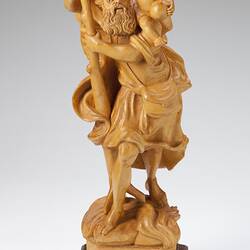Summary
Josef Moser migrated to Australia in 1982 from Austria. A wood sculptor, particularly of Catholic religious art, he was able to continue and adapt his craft in his new country.
'Oh, my father was in wood carving, which I do, and so was my grandfather and my great grandfather. I am very lucky to inherit some of the skills of my ancestors in wood carving.'
Early Life
Born in 1949 in the town of Stratberg, Austria, Josef Moser learnt the art of wood carving by watching his father and working alongside him. His family have a tradition of wood carving dating to the early 1600s when the family home and attached workshop were built. His mother also played an important part in the development of Josef's art practice, teaching him the process of gilding. Although Joseph did small carvings for teachers and friends while he was at school, his father encouraged him to work in the hotel industry where he could make better money.
Leaving school and home at 14 he worked in Vienna for a year before moving to Rome, where he worked in all aspects of the hotel industry from waiting tables and cooking to administration. To maintain his carving skills he would carve figures from butter as decorations for the buffet. Josef spent about four years working in Rome which he loved for its art, history and architecture.
Fascinated by languages, he speaks German, Spanish, French, Italian, English, a little Japanese and Swiss-German. Josef moved to London to improve his English, and worked in about 10 different jobs over a six-month period before moving to Zurich, Switzerland.
After working in Switzerland for 12 years Josef decided he wanted a change and the chance to settle down. While working in Zurich he met several Australians who had encouraged him to migrate to Australia. Buying a house in Switzerland or Austria was too expensive so in January 1982 he migrated to Melbourne, Australia.
Life in Australia
Arriving in Melbourne Josef's first impressions of Australia were of total unfamiliarity: 'I arrived here in the mid-30s [degrees Celsius], hot, all the grass was yellow, burnt, it was flat near Tullamarine, no mountains. I thought, my God, 'where am I?'A trip to Mt Buffalo in the Victorian Alps shortly after his arrival restored a sense of comfort in its familiarity.
Josef spent three months working at the Queenscliff Hotel before deciding to begin wood carving again, moving to the Dandenongs in Melbourne's outer east. Initially he carved furniture, but before long he shifted to decorative pieces, often with a religious theme. Carvings for Catholic Churches and parishioners have been an important part of his business, and although there are fewer Roman Catholics in Australia than in Austria (and consequently a smaller market for his works) he has been able to create works for new Churches here.
Josef returns to Austria to visit family regularly and his parent's, brother and sister have all travelled to Australia to visit him. He feels his move to Australia has lived up to his expectations: 'I love it because it is pretty isolated still. Even in the city you get hectic, but people are basically very nice, they live in peace and it's politically very stable.'
Artistic Practice
When creating a carving Josef first draws the design, he then begins by carving the head and face and works his way down. While he will carve whatever a client requests, he most enjoys carving in the Baroque style and there is a strong religious element to much of his work. The permanence of wood carving is important to him: 'if you do a figure in a church it will be there for hundreds of years even when you are gone.which is nice'. He does feel there is a stronger appreciation of the tradition, skill and technique that goes into creating wood carvings in Europe than in Australia, with many of his commissions from individual's being from other European migrants.
More Information
-
Keywords
Austrian Immigration, Artistic Practices, Wood Carvings, Religions: Roman Catholic
-
Authors
-
Article types


